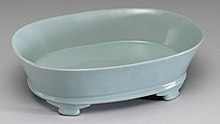


| Ru ware | |||||||||
|---|---|---|---|---|---|---|---|---|---|
| Traditional Chinese | 汝瓷 | ||||||||
| Simplified Chinese | 汝瓷 | ||||||||
| |||||||||
Ru ware, Ju ware, or "Ru official ware" (Chinese: 汝瓷) is a famous and extremely rare type of Chinese pottery from the Song dynasty, produced for the imperial court for a brief period around 1100. Fewer than 100 complete pieces survive, though there are later imitations which do not entirely match the originals. Most have a distinctive pale "duck-egg" blue glaze, "like the blue of the sky in a clearing amongst the clouds after rain" according to a medieval connoisseur,[1] and are otherwise undecorated, though their colours vary and reach into a celadon green.[2] The shapes include dishes, probably used as brush-washers, cups, wine bottles (carafes in modern terms), small vases, and censers and incense-burners. They can be considered as a particular form of celadon wares.[3]
Ru ware represents one of the Five Great Kilns identified by later Chinese writers. The wares were reserved for the Imperial court, with according to one contemporary source only those they rejected reaching a wider market. The source, Zhou Hui, also says the glaze contained agate, and when the kiln site was located in recent decades it was indeed very close to a site for mining agate, which is very largely composed of silica, a usual component of ceramic glazes. However, experts now discount any influence of agate in achieving the Ru glaze colour.[4] The bluish colour may be due to dissolved iron oxide with a very low amount of titanium dioxide.[5]
Ru ware is perhaps the first "official ware" specifically commissioned by the imperial court. Their normal practice seems to have been to review the large quantities of "tributary ware" given to them by the provinces making ceramics, effectively as a form of tax. The court kept what they wanted and redistributed the remainder as part of their lavish gifts to officials, temples, and foreign rulers, and perhaps also selling some.[6] Production ended when, or shortly before, the kilns were occupied by the invaders who overthrew the Northern Song dynasty in the 1120s, but the wares remained famous and highly sought after.
On 3 October 2017, a Ru ware brush-washer dish, 13 cm (5 in) across, set a new record auction price for Chinese ceramics at Sotheby's Hong Kong, fetching HK$294.3 million, nearly US$38 million.[7]
- ^ Sun (translation quoted); Sotheby's (2012). This description was also applied to the still rarer, and possibly mythical Chai ware of the 10th century, see Gompertz, 79–80 (and note 5); Rawson, 245
- ^ Sun; Sotheby's (2012)
- ^ Gompertz, 84; Vainker, 99; Sotheby's (2012); Sun
- ^ Vainker, 100; Sotheby's (2012)
- ^ Krahl, Regina; Harrison-Hall, Jessica (2009). Chinese Ceramics: Highlights of the Sir Percival David Collection. The British Museum Press. p. 27. ISBN 978-0714124544.
- ^ Rawson, 242; but see Vainker, 93
- ^ "Chinese Ru-ware bowl sets $38m auction record in Hong Kong", BBC News; Sotheby's video of the piece, 1.11 mins; Sotheby's (2017); in US$ the 2014 price for a doucai "chicken cup" was slightly higher, but the sale was also in Hong Kong, and the HK$ price lower.